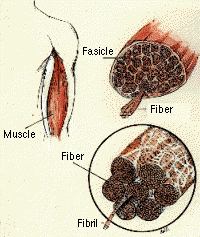| Visit our Sponsor Strongage.biz |
Tulloch's Health Tip: Aging Muscles | Age Strong with Strong Age
Senior Muscle Maintainer |
||
| Virus Defense Virus Facts Amino Acid Attack Reducing Arginine Compete w/ Arginine Virus Attack Aging Muscles Skin Tags
Jessica's Food Tips |
Muscles, like bone, are constantly being torn down and rebuilt by the body. Bone loss in post menopausal women has received considerable attention. This mechanism is fairly well understood. However, muscle loss in aging men and women has only recently been described. In terms of muscles, humans start to age at around 30. After the age of 40, humans start losing muscle at around 0.5-2% per year. Routine replacement of muscle tissue no longer keeps up with destruction. Exercise, especially resistance training, can build new muscle. But by the early 50s, even Herculean efforts begin to loose ground. Immediately after a meal degradation of muscle protein slows down and synthesis doubles in young humans. This change is caused by the arrival of a plentiful supply of amino acids. In older humans this supply is less effective. Rat studies, show the slow down in degradation that normally follows a meal does not occur in old animals, so there is excessive breakdown. Adding leucine to the diet restored a balanced metabolism. Researchers (Lydie Combaret, Dominique Dardevet and colleagues at the Human Nutrition Research Centre of Auvergne, INRA, Clermont-Ferrand, France) believe that the age-related problem results from defective inhibition of ubiquitin-proteasome dependent proteoloysis, a complex degradative machinery that breaks down contractile muscle protein, and that leucine supplementation can fully restore correct function. The study also found that elevated levels of peptidase enzymes and proteasome subunits characteristic of old muscle were suppressed in 22-month old rats chronically fed a leucine-supplemented diet.
|
Increasing Leucine
- Foods
The easiest way to increase your leucine intake is to consume foods high in this amino acid. Foods high in leucine include:
Increasing Leucine - Supplement Older humans seem to become less efficient in extracting nutrients from their food. This is often combined with a more sedentary lifestyle and a decrease in the quantity of food consumed. With these three factors working against them older humans are faced with a one-two punch in the fight to retain muscle mass. Thus, the only way to increase leucine bioavailability is through
supplements. Unfortunately, the correct amount of supplementation for
humans of various ages and body weight is unknown. On-the-other-hand, consistent evidence of toxicity has not been linked to leucine supplements. The Recommended Daily Allowance (RDA) is shown below. Note that this dosage is the minimum
human requirement per day needed to avoid serious deficiency. For therapeutic use of this nutrient, the dosage is usually increased considerably, but the toxicity level must be kept in mind. Professor Donald Layman from the University of Illinois, has pointed out that the average American diet contains 4 or 5 grams of leucine, "but to get the metabolic effects we're seeing, you need 9 or 10 grams”. Notice: The dosages presented here are NOT a recommendation by the author. Use this information sensibly. You are responsible for your own health! |
